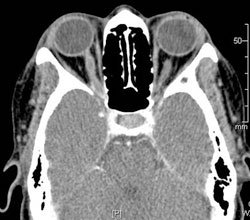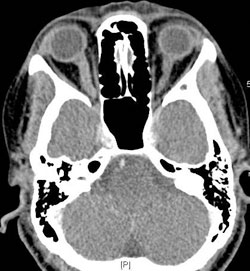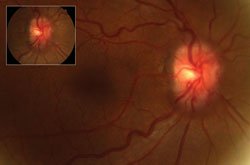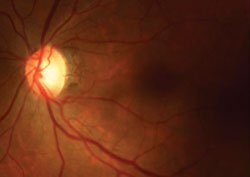Woman has slowly declining central vision
A mild afferent pupillary defect and optic disc edema were found on examination.
 Priti Batta |
 Namrata Nandakumar |
A 65-year-old woman presented with a complaint of decreased central vision in her right eye. Her vision had been slowly declining over several months. She was being followed by our glaucoma service as a glaucoma suspect secondary to asymmetrical optic disc appearance and low central corneal thickness.
Her medical history was significant for rheumatic heart disease, for which she had a mitral valve replacement several years ago. Her medications included warfarin, furosemide, digoxin, atenolol and aspirin. She had no family history of ocular disease. She denied smoking, drinking or illicit drug use.
Examination
On examination, the patient’s best corrected visual acuity was 20/60 in the right eye and 20/20 in the left. On pupillary examination, she had a mild relative afferent pupillary defect in the right eye. Consistent with this, color vision was slightly diminished in the right eye. Hertel’s exophthalmometry revealed 1 mm of relative proptosis of the right eye. Confrontational visual field testing suggested an inferior field defect in the right eye. IOPs were in the low teens in both eyes. Extraocular motility appeared full in both eyes. Anterior segment examination was normal except for mild nuclear sclerotic cataracts.
|
|
|
|
Figures 1a and 1b. Fundus examination of the
right eye reveals optic disc hyperemia and swelling and collateral vessels (1a,
inset). Fundus examination of the left eye is normal except for mild cupping of
the optic disc (1b).
Images: Batta P, Hedges
TR |
|
Fundus examination revealed hyperemia and edema of the right optic disc, along with collateral vessels along the nasal disc margin (Figure 1a). The left optic disc revealed mild cupping but was otherwise normal, with no disc edema or pallor (Figure 1b). Fundus examination was otherwise normal in both eyes.
OCT imaging confirmed the presence of optic disc edema in the right eye. Humphrey visual field testing suggested an inferior field defect in the right eye.

What is your diagnosis?
Optic disc swelling with collateral vessels
Collateral vessels of the optic disc, historically termed optociliary shunt vessels, actually represent dilation of pre-existing venous channels that shunt blood flow from the retinal to the peripapillary choroidal circulation. These vessels dilate over time in response to chronic central retinal vein obstruction, which causes congestion of these vascular channels. Typically, this is seen in cases of slow-growing optic nerve tumors directly compressing the optic nerve, causing optic disc swelling that, in turn, compresses the central retinal vein. It is also seen in chronically elevated intracranial pressure causing papilledema.
The most common condition associated with retinochoroidal collateral vessels is an optic nerve sheath meningioma. These are insidiously slow-growing tumors of the optic nerve sheath, more common in women than in men. The classic triad, termed the Hoyt-Spencer sign, includes painless progressive monocular loss of vision, optic disc atrophy and the presence of retinochoroidal collateral vessels on the optic disc. This triad, although fairly specific for optic nerve sheath meningioma, is only present in about 20% of cases. Virtually all patients present with some abnormality of the optic disc appearance, with optic disc atrophy being a slightly more common presenting sign than optic disc swelling. Other symptoms and signs of optic nerve sheath meningioma include gaze-evoked amaurosis, strabismus, proptosis and, infrequently, pain. On neuroradiological imaging, these tumors usually present with tubular expansion of the optic nerve, with peripheral enhancement (the “tram-track” sign).
Other tumors associated with retinochoroidal collateral vessels include sphenoid wing meningioma and optic nerve glioma. As mentioned earlier, elevated intracranial pressure, either from pseudotumor cerebri or an intracranial tumor, can also be associated with these vessels. Chronic central retinal vein obstruction and optic disc drusen have also been reported as rare etiologies.
Diagnosis and management
The patient underwent CT imaging of the brain, which demonstrated tubular enlargement of the right optic nerve consistent with a diagnosis of optic nerve sheath meningioma (Figure 2).
 Figure 2. CT imaging of the brain revealed mild tubular enlargement of the right optic disc. |
 Figure 3. Follow-up CT imaging one year later suggested a slight increase in size of the optic nerve sheath meningioma. |
Optic nerve sheath meningiomas are most frequently managed by observation, as these tumors are slow-growing, often have only mild effects on vision, and due to their location, are extremely difficult to resect. Prognosis is generally fairly good for these lesions. Saeed and colleagues studied 45 patients with optic nerve sheath meningiomas who had initial visual acuity of 20/50 or better; they found that 71% of these patients maintained stable visual acuity at 5-year follow-up. However, a long-term follow-up study published by Turbin and colleagues compared observation, radiation and surgery for these lesions and found that radiation had the best outcome, regardless of initial visual acuity. Stereotactic fractionated radiotherapy has been found to be highly effective, with a relatively low rate of side effects. Surgical debulking is rarely performed for these tumors and is usually only considered for intracranial extension or for highly localized, anterior and extradural tumors.
This patient was offered observation or irradiation as a treatment option. She chose observation. She recently had cataract surgery in that eye, and visual acuity improved to 20/25, although she complained of poor contrast. Recent Humphrey visual field testing showed more diffuse visual field loss, both inferiorly and superiorly. A repeat CT scan, done approximately 1 year after the initial scan, showed slightly increased tubular expansion of the optic nerve sheath (Figure 3). The patient still prefers observation. She will continue to follow up in clinic every 6 months, with neuroimaging planned at yearly intervals.
References:
- Eggers HM, Sanders MD. Acquired optociliary shunt vessels in papilloedema. Brit J Ophthalmol. 1980;64(4):267-271.
- Jeremic B, Pitz S. Primary optic nerve sheath meningioma: stereotactic fractionated radiation therapy as an emerging treatment of choice. Cancer. 2007;110(4):714-722.
- Miller NR. New concepts in the diagnosis and management of optic nerve sheath meningioma. J Neuroophthalmol. 2006;26(3):200-208.
- Saeed P, Rootman J, Nugent RA, White VA, Mackenzie IR, Koornneef L. Optic nerve sheath meningiomas. Ophthalmol. 2003;110(10):2019-2030.
- Turbin RE, Thompson CR, Kennerdell JS, Cockerham KP, Kupersmith MJ. A long-term visual outcome comparison in patients with optic nerve sheath meningioma managed with observation, surgery, radiotherapy, or surgery and radiotherapy. Ophthalmol. 2002;109(5):890-900.
- Tyson SL, Lessell S. Resolution of optociliary shunt vessels. J Clin Neuroophthalmol. 1986;6(4):205-208.
- Vagefi MR, Larson DA, Horton JC. Optic nerve sheath meningioma: visual improvement during radiation treatment. Am J Ophthalmol. 2006;142(2):343-344.
- Priti Batta, MD, and Thomas R. Hedges III, MD, can be reached at New England Eye Center, Tufts University School of Medicine, 750 Washington St., Box 450, Boston, MA 02111; 617-636-4219; fax: 617-636-4866; website: www.neec.com.
- Edited by Priti Batta, MD, and Namrata Nandakumar, MD. Drs. Batta and Nandakumar can be reached at New England Eye Center, Tufts University School of Medicine, 750 Washington St., Box 450, Boston, MA 02111; 617-636-4219; fax: 617-636-4866; website: www.neec.com.



